The Dog Training Equipment Market is estimated to be valued at USD 2.5 billion in 2025 and is projected to reach USD 4.8 billion by 2035, registering a compound annual growth rate (CAGR) of 6.7% over the forecast period. During the initial five years from 2020 to 2025, the market expands from USD 1.8 billion to USD 2.5 billion, contributing an incremental gain of USD 0.7 billion.
This growth phase is driven by rising pet ownership, increasing awareness about pet behavior management, and growing demand for effective and humane training tools. Year-on-year values such as USD 1.9 billion in 2021, USD 2.1 billion in 2022, USD 2.2 billion in 2023, and USD 2.5 billion in 2024 reflect steady progress, supported by innovations in training collars, leashes, and interactive training devices.
From 2026 to 2030, the market advances from USD 2.7 billion to USD 3.5 billion, propelled by increased adoption of electronic training devices and digital platforms offering remote training solutions. The trend toward positive reinforcement and non-aversive training methods further supports market expansion. Between 2031 and 2035, the market accelerates from USD 3.7 billion to USD 4.8 billion, driven by technological advancements in smart collars, GPS trackers, and behavior monitoring systems.
Growing e-commerce penetration and rising disposable incomes globally contribute to enhanced accessibility and consumer spending. Overall, the dog training equipment market is positioned for sustained and robust growth through 2035, fueled by evolving pet care practices, technological innovation, and increasing demand for effective training solutions.
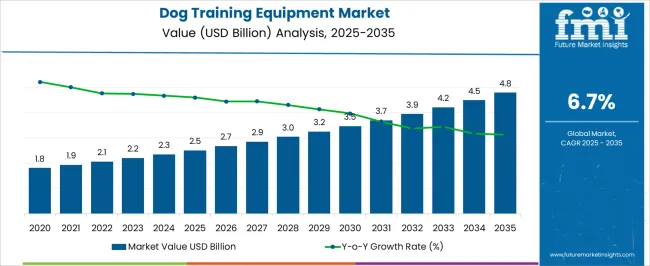
| Metric | Value |
|---|---|
| Dog Training Equipment Market Estimated Value in (2025 E) | USD 2.5 billion |
| Dog Training Equipment Market Forecast Value in (2035 F) | USD 4.8 billion |
| Forecast CAGR (2025 to 2035) | 6.7% |
An emerging trend toward positive reinforcement methods and personalized training regimens is prompting demand for a wide range of durable, safe, and ergonomically designed training tools. Investments in pet care infrastructure, such as specialized training academies and behavior clinics, have also accelerated the uptake of professional-grade equipment. Moreover, urban pet owners are increasingly seeking solutions that allow for at-home behavioral correction and leash training, particularly in compact living environments.
With social media playing a strong role in pet care awareness, product innovation is being influenced by user-generated content and influencer recommendations. Continued focus on high-quality materials, regulatory standards for safety, and product customization is expected to drive growth across both commercial and domestic use cases.
The dog training equipment market is segmented by product type, material type, end use, and geographic regions. The dog training equipment market is divided by product type into Leashes, collars, and harnesses, Clickers and whistles, Treat bags, Agility equipment, Muzzles, and Other product types. The dog training equipment market is classified by material type into Nylon, Leather, Plastic, and Other materials.
The end use of the dog training equipment market is segmented into Professional training centers, Military and service organizations, Dog training schools and academics, and Other end uses. Regionally, the dog training equipment industry is classified into North America, Latin America, Western Europe, Eastern Europe, Balkan & Baltic Countries, Russia & Belarus, Central Asia, East Asia, South Asia & Pacific, and the Middle East & Africa.
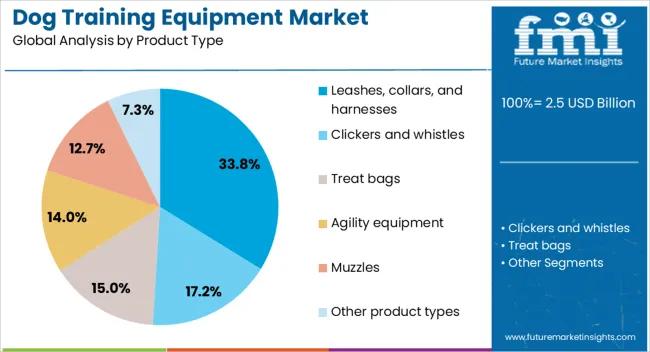
Leashes, collars, and harnesses are expected to account for 33.80% of the total market revenue in 2025, making them the dominant product category. This leadership is attributed to their foundational role in both basic obedience training and advanced behavior correction.
These products are widely accepted due to their versatility in indoor, outdoor, and structured training environments. Increased consumer preference for multi-functional and adjustable gear has encouraged manufacturers to introduce padded, reflective, and quick-release designs, improving safety and comfort for pets.
Regulatory emphasis on leash laws in urban areas and public safety campaigns has also reinforced the importance of reliable restraint tools. As training methodologies shift toward non-invasive and mobility-friendly options, demand for ergonomic and customized leashing equipment continues to rise.
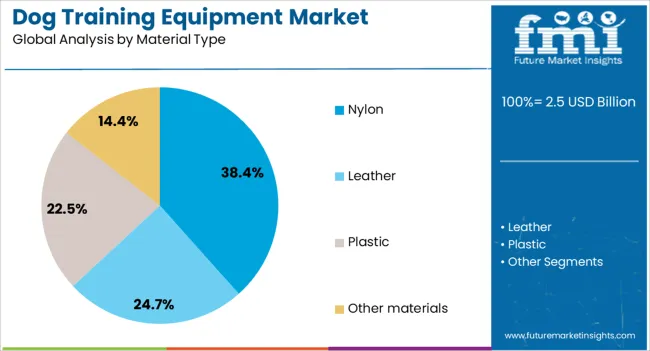
Nylon is projected to hold 38.40% of the total revenue in 2025, positioning it as the leading material type in the dog training equipment market. This prominence stems from nylon’s lightweight durability, water resistance, and cost-effectiveness compared to alternatives like leather or metal.
Its high tensile strength ensures safety during high-impact training exercises, especially for larger or more energetic breeds. Nylon-based products are also easily washable and maintain their structural integrity over time, making them preferred for both casual pet owners and professional trainers.
The material’s adaptability for weaving, padding, and color customization supports innovation in product aesthetics and function. Furthermore, sustainable variants such as recycled nylon are gaining traction, appealing to environmentally conscious consumers without compromising performance.
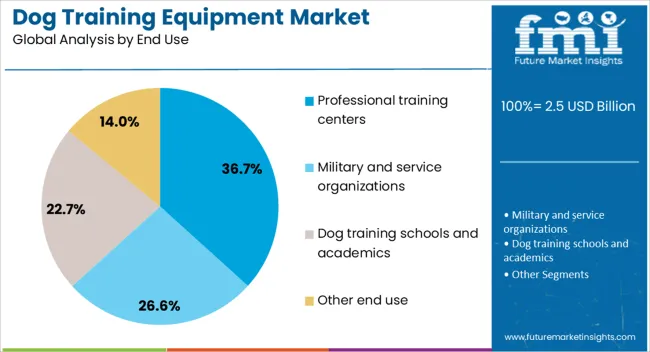
Professional training centers are anticipated to contribute 36.70% of the total market revenue in 2025, establishing them as the dominant end-use segment. This growth is being driven by the expansion of certified dog training academies, veterinary rehabilitation centers, and behavior modification clinics.
These centers typically require standardized, regulation-compliant, and high-durability equipment for repeated, intensive use. The professional segment favors tools that allow for modular training programs, including agility courses, restraint systems, and positive reinforcement aids.
Increased demand for service dogs, therapy animals, and specialized obedience training has further stimulated equipment procurement by training institutions. Strategic partnerships with equipment manufacturers and the need for performance-evaluated gear continue to support this segment’s leading share.
The dog training equipment market is driven by increasing demand for professional solutions, specialization, and customization, along with the expansion of e-commerce channels. The growing focus on safety and comfort in product design further enhances market growth.
The growing interest in professional dog training has spurred the demand for specialized dog training equipment. As pet owners become more committed to training their dogs effectively, there is a rising demand for tools that can help with obedience, behavior correction, and agility. Training equipment, such as clickers, leashes, agility tunnels, and electronic collars, has gained popularity among owners seeking to improve their pets' behavior and skills. The desire for well-trained pets is linked to the increasing value placed on pets as family members, with owners increasingly willing to invest in training solutions that deliver long-term benefits.
A significant shift is occurring in the demand for specialized and customizable dog training equipment. Pet owners are seeking tools that cater to specific breeds, training techniques, or behavioral issues. Agility training tools, such as hurdles and weave poles, have gained traction in the competitive dog training and sports market. Electronic training collars, which offer adjustable settings for remote training, are gaining popularity for behavioral training, especially for larger or more difficult breeds. The customization trend is reflected in products designed for specific training needs, such as tools for potty training or leash pulling reduction, catering to a broad range of dog behavior issues.
The increasing popularity of e-commerce platforms is reshaping the dog training equipment market. Consumers now have easier access to a wide variety of dog training products through online retailers, making it easier to purchase equipment from the comfort of their homes. E-commerce platforms offer competitive pricing, customer reviews, and product variety, which enhances the shopping experience. The convenience and variety offered by online stores have contributed to increased sales, especially for niche and specialized training tools. Additionally, online retail channels are fostering better consumer education by providing tutorials, user guides, and expert advice, helping owners make informed purchasing decisions.
As pet owners become more aware of the potential risks associated with certain training tools, there is a growing emphasis on safety and comfort in the design of dog training equipment. Products such as collars, harnesses, and leashes are being manufactured with pet-friendly materials to ensure the dog's well-being during training. There is an increased focus on designing tools that minimize discomfort or injury, particularly with electronic training collars. Manufacturers are responding by introducing products with adjustable settings and softer materials that allow for gentle yet effective training. This shift towards more pet-centric training equipment is driving market growth as owners prioritize their pets' safety and comfort while using training tools.
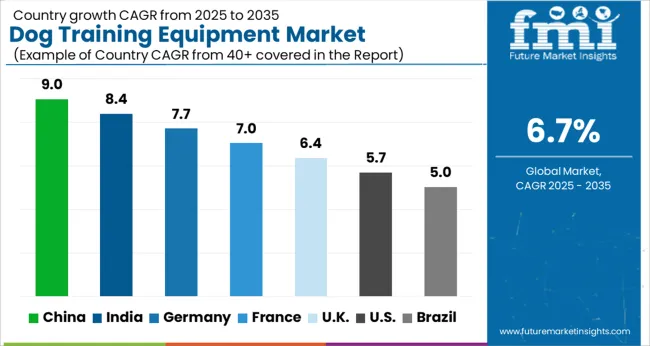
The dog training equipment market is projected to grow globally at a CAGR of 6.7% from 2025 to 2035, driven by increasing pet ownership, rising interest in dog behavior training, and advancements in training technologies. China leads with a CAGR of 9.0%, driven by the growing pet care industry, rising disposable incomes, and a shift towards premium pet products. India follows at 8.4%, supported by increasing pet adoption, particularly in urban areas, and growing awareness about proper pet training.
France grows at 7.0%, driven by a rise in pet training services and increasing demand for high-quality, effective dog training tools. The United Kingdom achieves a CAGR of 6.4%, with the increasing number of dog owners and a strong emphasis on pet health and behavioral development. The United States records a CAGR of 5.7%, supported by high demand for dog training services, online training solutions, and pet behavior management products. This growth trajectory reflects the growing recognition of the importance of proper pet training, increased focus on dog behavior management, and the rising popularity of innovative dog training equipment globally.
The UK’s dog training equipment market grew at a CAGR of 5.5% from 2020 to 2024 and is expected to rise to 6.4% during 2025-2035. The moderate growth during 2020-2024 was driven by steady demand for basic training equipment as pet ownership continued to rise. However, the market is expected to accelerate in the coming decade due to increasing awareness about the benefits of professional dog training, a rise in pet ownership, and growing demand for specialized training equipment. The trend toward more sophisticated training tools, such as electronic collars, agility equipment, and interactive toys, will further support market growth. Additionally, the increasing popularity of online dog training platforms and the expansion of pet care services will likely push demand for advanced training products. The market's growth will also be influenced by the rise of urban pet owners seeking effective solutions for behavior management.
China’s dog training equipment market is projected to grow at a CAGR of 9.0% during 2025-2035, exceeding the global CAGR of 6.7%. The market grew at a CAGR of 7.2% from 2020 to 2024, driven by an increase in pet adoption, particularly in urban areas, and rising awareness about pet training. The rapid expansion of pet care products and services in China will contribute to higher demand for specialized dog training equipment. The acceleration in growth in the coming decade is attributed to rising disposable incomes, urbanization, and the increasing emphasis on responsible pet ownership and training. Additionally, the Chinese market is witnessing the rise of pet training centers and online training platforms, leading to a higher demand for training tools and accessories.
India’s dog training equipment market is expected to grow at a CAGR of 8.4% from 2025 to 2035, above the global average of 6.7%. The market grew at a CAGR of 6.8% from 2020 to 2024, driven by an increase in pet adoption, particularly in urban areas, and the growing interest in pet behavior management. The market is expected to accelerate in the coming decade due to a higher number of pet owners seeking effective training solutions for their dogs. The expanding availability of dog training services, both online and offline, and the rise of awareness regarding pet behavior will further fuel the demand for dog training equipment. The availability of a wide range of training products and increasing disposable income in urban areas will also drive market growth.
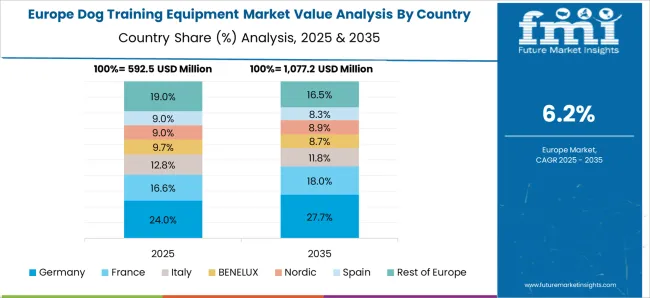
France’s dog training equipment market is expected to grow at a CAGR of 7.0% during 2025-2035. The market grew at a CAGR of 6.0% from 2020 to 2024, supported by steady demand in the pet care sector. The expected rise in the coming decade will be driven by increasing awareness of pet behavior training, the growing popularity of pet training centers, and the demand for advanced, customizable dog training tools. The market in France will also be driven by a focus on high-quality, durable equipment that aligns with the country’s high standards in pet care and training. The expanding use of technology in pet training, including app-controlled devices and virtual training services, will boost demand for advanced training equipment.
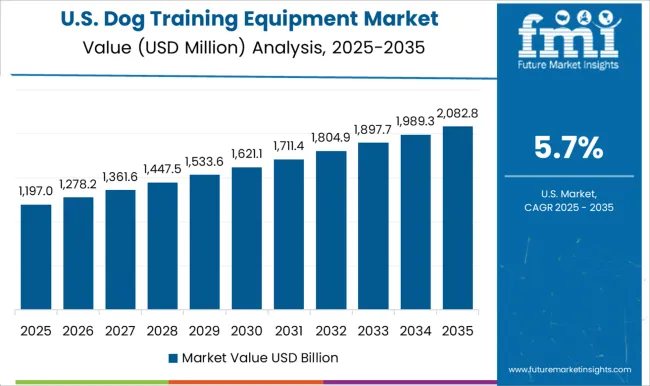
The USA dog training equipment market is projected to grow at a CAGR of 5.7% during 2025-2035. The market grew at a CAGR of 5.0% from 2020 to 2024, driven by a strong pet care industry, rising pet ownership, and a growing focus on responsible pet behavior. The increase in demand for premium training products and the growing popularity of online dog training services will accelerate growth in the coming decade. Additionally, pet training equipment that integrates with mobile apps or smart technology will likely experience higher adoption due to the rise in tech-savvy pet owners seeking innovative solutions for training and behavior management.
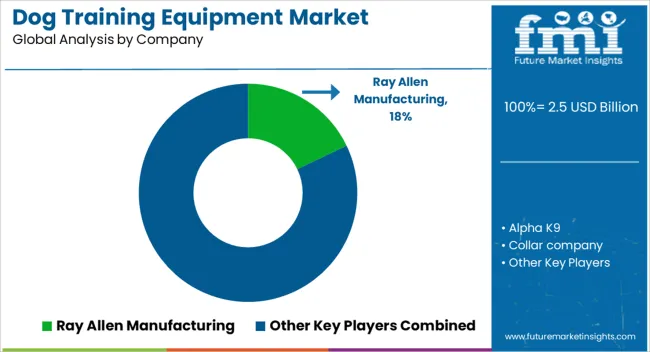
The dog training equipment market is highly competitive, with key players offering a wide range of products aimed at improving pet behavior and training outcomes. Ray Allen Manufacturing is a leading player with its premium dog training equipment, including leashes, collars, and harnesses, known for durability and quality. Alpha K9 specializes in advanced K9 training gear, offering innovative solutions for police and military working dogs, along with a range of training accessories.
The Collar Company stands out for its electronic training collars and remote training devices, designed for effective control over larger or more difficult dogs. EzyDog delivers comfort-focused products such as harnesses, leashes, and dog training accessories, combining ergonomic designs with high functionality. Hanyang offers a diverse range of professional training tools for both dogs and their handlers, positioning itself as a prominent supplier in the Asia-Pacific region.
Heads Up for Tails, a well-known brand in India, provides a variety of dog training products, including behavior correction collars and training leashes, designed for urban pet owners. Leeburg specializes in manufacturing high-quality leather dog training collars and leashes, while Mid-State K9 is known for its performance-focused training gear and K9 working dog products.
Petarchi and Pets Like provide innovative training solutions with a focus on eco-friendly materials and affordability, targeting a broad consumer base. Supertails and Von Wolf K9 offer premium products, emphasizing safety, comfort, and durability for various dog training needs. Wayfair, primarily known for home products, has expanded into the pet care market, providing dog training equipment from multiple manufacturers.
Competitive strategies focus on product differentiation, incorporating high-quality materials, advanced training technologies, and addressing specific training needs. These players continue to enhance their offerings through customization options, expansion of product lines, and adoption of e-commerce platforms to reach a larger customer base.
Collars hold a dominant share in the pet accessory market. In North America, they account for approximately 30%-35% of total sales in the pet accessories segment, followed by leashes and training tools. Leashes are a close second in market share, representing about 25%-30% of the market. Demand is split between standard leashes, retractable leashes, and leashes with comfort features like padded handles.
| Item | Value |
|---|---|
| Quantitative Units | USD 2.5 Billion |
| Product Type | Leashes, collars, and harnesses, Clickers and whistles, Treat bags, Agility equipment, Muzzles, and Other product types |
| Material Type | Nylon, Leather, Plastic, and Other materials |
| End Use | Professional training centers, Military and service organizations, Dog training schools and academics, and Other end use |
| Regions Covered | North America, Europe, Asia-Pacific, Latin America, Middle East & Africa |
| Country Covered | United States, Canada, Germany, France, United Kingdom, China, Japan, India, Brazil, South Africa |
| Key Companies Profiled | Ray Allen Manufacturing, Alpha K9, Collar company, EzyDog, Hanyang, Heads up for tails, Leeburg, Mid-State K9, Petarchi, Pets Like, Supertails, Von Wolf K9, and Wayfair |
| Additional Attributes | Dollar sales, and growth trends by region and product type. They would seek data on market share by category, consumer preferences for training methods, and the demand for specific tools like collars and leashes. Insights into competitive landscape, key players, and their share, pricing trends, and distribution channels would be essential. |
The global dog training equipment market is estimated to be valued at USD 2.5 billion in 2025.
The market size for the dog training equipment market is projected to reach USD 4.8 billion by 2035.
The dog training equipment market is expected to grow at a 6.7% CAGR between 2025 and 2035.
The key product types in dog training equipment market are leashes, collars, and harnesses, clickers and whistles, treat bags, agility equipment, muzzles and other product types.
In terms of material type, nylon segment to command 38.4% share in the dog training equipment market in 2025.






Our Research Products

The "Full Research Suite" delivers actionable market intel, deep dives on markets or technologies, so clients act faster, cut risk, and unlock growth.

The Leaderboard benchmarks and ranks top vendors, classifying them as Established Leaders, Leading Challengers, or Disruptors & Challengers.

Locates where complements amplify value and substitutes erode it, forecasting net impact by horizon

We deliver granular, decision-grade intel: market sizing, 5-year forecasts, pricing, adoption, usage, revenue, and operational KPIs—plus competitor tracking, regulation, and value chains—across 60 countries broadly.

Spot the shifts before they hit your P&L. We track inflection points, adoption curves, pricing moves, and ecosystem plays to show where demand is heading, why it is changing, and what to do next across high-growth markets and disruptive tech

Real-time reads of user behavior. We track shifting priorities, perceptions of today’s and next-gen services, and provider experience, then pace how fast tech moves from trial to adoption, blending buyer, consumer, and channel inputs with social signals (#WhySwitch, #UX).

Partner with our analyst team to build a custom report designed around your business priorities. From analysing market trends to assessing competitors or crafting bespoke datasets, we tailor insights to your needs.
Supplier Intelligence
Discovery & Profiling
Capacity & Footprint
Performance & Risk
Compliance & Governance
Commercial Readiness
Who Supplies Whom
Scorecards & Shortlists
Playbooks & Docs
Category Intelligence
Definition & Scope
Demand & Use Cases
Cost Drivers
Market Structure
Supply Chain Map
Trade & Policy
Operating Norms
Deliverables
Buyer Intelligence
Account Basics
Spend & Scope
Procurement Model
Vendor Requirements
Terms & Policies
Entry Strategy
Pain Points & Triggers
Outputs
Pricing Analysis
Benchmarks
Trends
Should-Cost
Indexation
Landed Cost
Commercial Terms
Deliverables
Brand Analysis
Positioning & Value Prop
Share & Presence
Customer Evidence
Go-to-Market
Digital & Reputation
Compliance & Trust
KPIs & Gaps
Outputs
Full Research Suite comprises of:
Market outlook & trends analysis
Interviews & case studies
Strategic recommendations
Vendor profiles & capabilities analysis
5-year forecasts
8 regions and 60+ country-level data splits
Market segment data splits
12 months of continuous data updates
DELIVERED AS:
PDF EXCEL ONLINE
Dog Treat Launcher Market Size and Share Forecast Outlook 2025 to 2035
Equipment Management Software Market Size and Share Forecast Outlook 2025 to 2035
Equipment cases market Size and Share Forecast Outlook 2025 to 2035
Dog Footwear Market Size and Share Forecast Outlook 2025 to 2035
Dog Vaccine Market Size and Share Forecast Outlook 2025 to 2035
Dog Food Market Analysis - Size, Share, and Forecast 2025 to 2035
Dog Intestinal Health Pet Dietary Supplement Market Size and Share Forecast Outlook 2025 to 2035
Dog Food and Snacks Market Size and Share Forecast Outlook 2025 to 2035
Dog Float Market Size and Share Forecast Outlook 2025 to 2035
Dog Gates, Doors, & Pens Market Analysis - Trends, Growth & Forecast 2025 to 2035
Dog Safety Leash Market Analysis - Trends, Growth & Forecast 2025 to 2035
Dog Collars Market Analysis - Trends, Growth & Forecast 2025 to 2035
Training Shoes Market Analysis - Size, Trends & Forecast 2025 to 2035
Dog Dental Chews Market Analysis by Product Type, Age, Flavor, Application and Sales Channel Through 2035
Dog Collars, Leashes & Harnesses Market Analysis by Dog Collars, Dog Leash, Dog Harness, Material Type, Distribution Channel and Region Through 2025 to 2035.
Competitive Overview of Dog Gates, Doors and Pens Companies
Dog Food Topper Market Analysis - Size, Share, and Forecast 2024 to 2034
Dog Food Flavours Market
Farm Equipment Market Forecast and Outlook 2025 to 2035
Golf Equipment Market Size and Share Forecast Outlook 2025 to 2035

Thank you!
You will receive an email from our Business Development Manager. Please be sure to check your SPAM/JUNK folder too.
Chat With
MaRIA